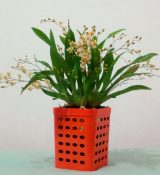Common Orchid Plant Diseases – Bacterial Root Rot
Author: adminNo Comments
There are several types of rot diseases that you should look out for when caring for an orchid plant. Some of the more common diseases affect not only the leaves, but the buds and roots as well. If left untreated your plant could be facing death, or worse, it could spread to other plants in your home or office (resulting in the death of several plants, rather than just the plant that it originated from). The best care is always prevention, so make sure that you are tending to your orchid plant regularly, and giving it the optimal care it needs to grow and stay healthy. Read on and learn about this specific type of rot, and how to spot, and treat it.
Bacterial Root Rot
- Symptoms – Bacterial root rot is a common orchid plant disease. This particular bacteria thrives in high temperature and high humidity (be aware of the watering and humidity guidelines for optimal growth because over-watering is a large culprit here). In the early stages of bacterial root rot, you’ll notice a slight shriveling of the lower leaves of your orchid plant. Once root rot has set into the leaves, they’ll turn yellow in color, and eventually the plant will die due to the lack of nutrients. If detected at an early stage, the bacterial root rot can be reversed.
- Control – Like I’ve stated many times before, the best method for control is prevention. Some of the main contributing factors to bacterial root rot are water logging of the media, compacted media with poor ventilation, higher acidity of decomposed media, and too strong fertilizer. So be sure to research the optimal growing guidelines that are suggested here first, before you decide that the orchid is the right plant for you. But if you are beyond prevention, then you’ll want to start off by re-potting your orchid plant. After you dump out all of the media from the orchid’s pot, be sure to sanitize your container to prevent the rot from spreading to another plant. When you take the plant out of the pot you will notice that the roots are dark and soft. You’ll want to be sure to remove any bad roots and any left over media. The roots should be fairly easy to remove; you can either pluck them off (the roots are soft, so they should break off easily), or use a clean/sterile tool to remove them. Use a smaller pot this time and re-plant your orchid in fresh media. Place the orchid plant in an area where there is air is high in humidity and good ventilation. Do not water for several days; giving the roots some time for recovery, then water less frequently than you have in the past. Be sure to cut back on the amount you fertilize during this period of time.


Ask an Expert
Questions about orchids?
Our experts love a challenge!
Photo of the Week
Submit your photo to be featured on the blog!
More Photo of the Week Winners
Submit Photo







